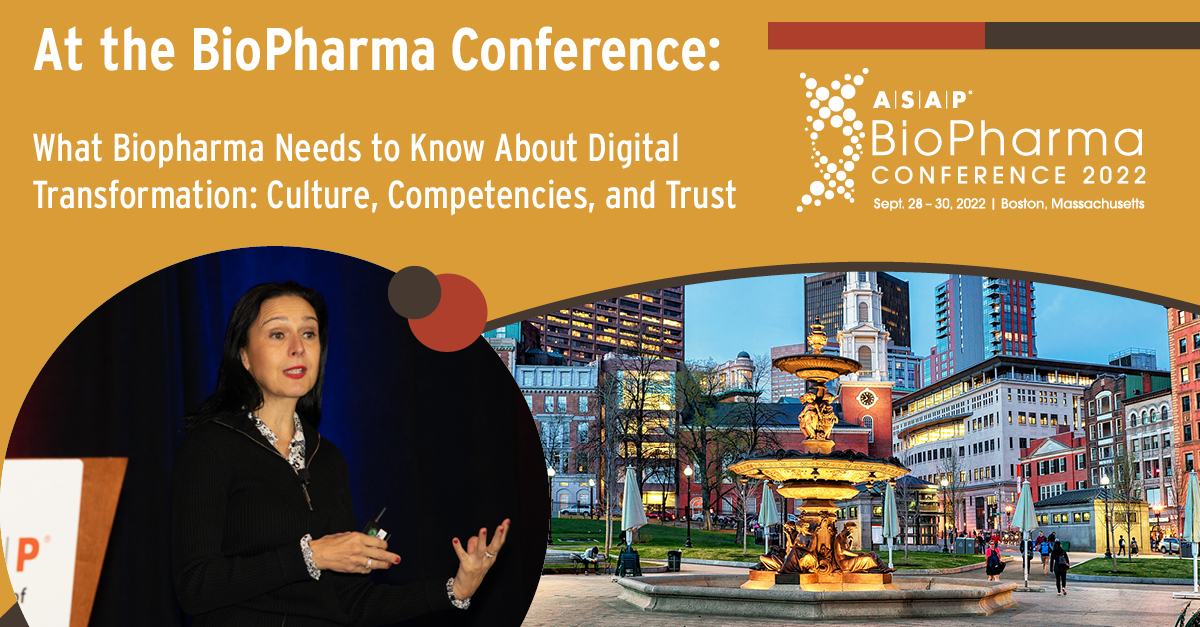What Biopharma Needs to Know About Digital Transformation: Culture, Competencies, and Trust
While the intersection of pharma and IT is still in its early phase, we’re starting to see glimpses of advancements in discovery, clinical trials, and patient care that collaborations between the two industries can deliver—advanced diagnoses, new drug candidates, and more efficient lab settings, to name a few. And there’s more to come once the players in the two industries truly learn to work together.
“It’s one of the most pressing [topics] in our industry—that is, the relationship between tech and biopharma,” said David Thompson, CSAP, chief alliance officer at Eli Lilly and Company and ASAP board chairman. “That grouping is leaning in towards each other in ways that I never imagined when I started my career.”
Since alliance professionals are going to be front and center fostering these collaborations and delivering outcomes that can potentially change healthcare in ways too profound for many of us laypeople to imagine, the 2022 ASAP BioPharma Conference dedicated a session to answering the question, “What Do Alliance Managers Need to Know About Digital Transformation?”
In her keynote address, Elena Bonfiglioli, general manager of worldwide healthcare and pharma and life sciences strategy lead at Microsoft, came up with a three-part answer to the eponymous session title question based on learnings from her organization’s major alliances with Novartis, AstraZeneca, and a whole host of nonprofits: 1) culture, 2) competencies, and 3) trust.
Privacy Must Be in the Blood of Tech-Pharma Collaborations
Much of the discussion of culture, as framed by Bonfiglioli, concerned balancing the need to mine gigantic volumes of patient, clinical, and various other forms of third-party data without overstepping personal boundaries of the people whose personal data is being analyzed. Bonfiglioli framed the challenge as having to harness this valuable data but “do it with trust and respect for the lifetime vales of privacy and security.”
“How do you use data? What is the right parameter? What is the responsibility [around] security and privacy? What are the imperatives that will make it so data becomes an enabler not something that you would have to be worried about?” she said.
Later in the Q&A session, Bonfiglioli listed advancements in “privacy-enhancing solutions” that may help in striking this balance, including new ways of enabling algorithms to interact with data with “minimal touch,” tracking prevention technology, and the practice of mixing “synthetic data” in with real data so that data sets aren’t “re-identifiable.” However, it’s up to the public, private, and nonprofit sectors to not just utilize technologies of this kind but to fully embed privacy preservation into our mindsets and cultures so that it becomes “the de facto way of doing business.” She pointed out that people have little problem donating data for targeted cancer and rare disease research. She also cited blood banks as a possible roadmap for normalizing the use of genetic, patient history, and other types of highly personal data.
“We don’t ask questions when we get our blood drawn,” she noted. “If people, alliances, and companies are clear on the purpose of sharing the data, patients are hyper-willing to share. The problem is when it’s the black box.”
New Platforms Mine “Historic Influx in Data”
With the right culture in place, the pharmaceutical industry now needs to reap the benefits Artificial Intelligence (AI), Machine Learning (ML), deep learning, quantum computing, and other computational capabilities can mine from massive amounts of medical records, IoT telemetry, social media feeds, videos, and other data sources, even “natural interaction.”
“We’re witnessing a historic influx in data,” reminded Bonfiglioli.
Do so and you can transform every element of the biopharma lab, supply chain, and shop floor, but you will need new platforms to extract and visualize these insights around every phase of the drug life cycle, from discovery, validation, and detection and diagnosis to the production of new medicine and that “last mile” delivery to the patient. We have already gotten a glimpse of what’s possible. Bonfiglioli recounted how supply chain specialists were able to get remote assistance from colleagues via 3-D technology during the pandemic. She also cited a Microsoft collaboration that allows clinicians to query years’ worth of clinical trials data as easily as using Excel.
Share Your Lunch, Ditch the SEO Model
When it comes to that third pillar, trust, Bonfiglioli suggested that Microsoft and other tech giants are going to have to reengineer their thinking, business models, and usual modus operandi if they want to deliver on the promise of precision medicine. First, it’s time to ditch the coopetition approach, in which you partner with a company in an unfamiliar industry, learn the ropes, and then “little by little, I’m going to eat your lunch. I’m going to compete with you,” she said. Second, the tech industry can’t view data through its usual SEO monetization lens.
“There’s an intrinsic utility in data that’s different from the price of data. How do we apply AI computing capabilities to all of our customers to extract that utility going beyond a commercial marketing/advertising model? That’s what I would say is a key challenge for alliance managers both on the biopharma and tech sides,” said Bonfiglioli.
Bonfiglioli had more wisdom to share in her presentation, including additional case studies illustrating advanced data and analytics technology in action around leprosy risk, cardiovascular ailment diagnosis, and gastric cancer research, among other collaborations. 2022 ASAP BioPharma Conference registrants can still view the presentation in the event portal.

